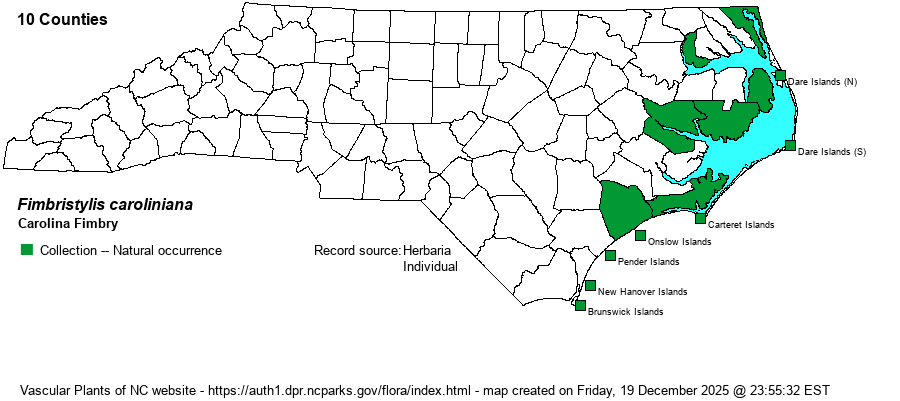| Author | (Lamarck) Fernald | |
| Distribution | Outer Coastal Plain and Outer Banks, ranging inland only to Chowan and Beaufort counties.
Maritime, NJ to southern FL and southern TX; Yucatan; West Indies. | |
| Abundance | Frequent, and quite widespread, along the coast; lacking specimens for only a few counties that border coastal and tidal waters. The website editors suggest a State Rank of S4. | |
| Habitat | Brackish and fresh-tidal marshes, maritime wet grasslands. Elsewhere in its range occurs also in pine savannas and flatwoods, but apparently not in NC. | |
| Phenology | Flowering and fruiting July-September. | |
| Identification | This is a robust fimbry, with the stems potentially up to 4 feet tall but usually half that (which is still much taller than most others in the state). It is very similar to F. castanea, but its leaves are relatively thin and flat or V-shaped in life (vs. thick and semicircular in cross-section in F. castanea) and its seeds are less than 1.5 mm long (vs. 1.5-2 mm long in that species). | |
| Taxonomic Comments | In some older texts, both F. caroliniana and F. castanea were lumped under F. spadicea (L.) Vahl.
Plants of the the genus Fimbristylis are very small to tall (3+ feet), with most leaves in a basal tuft, and an open, branched, terminal inflorescence. The spikelets are various shades of rufous, chestnut, or brown (due to the color of the scales) and resemble tiny pinecones. Important key characters include size, shape, and ornamentation of the achenes (seeds); see also other characters used by Weakley (2018). Godfrey & Wooten (1979) have excellent drawings and descriptions. | |
| Other Common Name(s) | Tufted Fimbry | |
| State Rank | [S4] | |
| Global Rank | G4 | |
| State Status | | |
| US Status | | |
| USACE-agcp | OBL link |
| USACE-emp | | |

